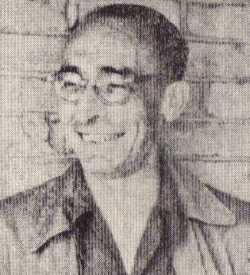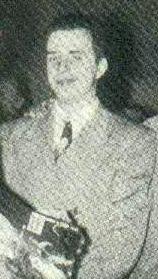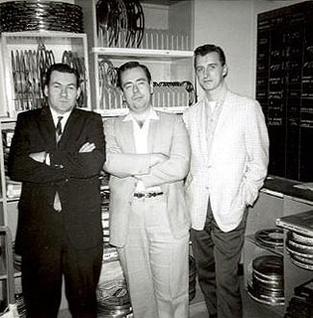Related Research Articles

Robert Albert Bloch was an American fiction writer, primarily of crime, psychological horror and fantasy, much of which has been dramatized for radio, cinema and television. He also wrote a relatively small amount of science fiction. His writing career lasted 60 years, including more than 30 years in television and film. He began his professional writing career immediately after graduation from high school, aged 17. Best known as the writer of Psycho (1959), the basis for the film of the same name by Alfred Hitchcock, Bloch wrote hundreds of short stories and over 30 novels. He was a protégé of H. P. Lovecraft, who was the first to seriously encourage his talent. However, while he started emulating Lovecraft and his brand of cosmic horror, he later specialized in crime and horror stories working with a more psychological approach.

Edmond Moore Hamilton was an American writer of science fiction during the mid-twentieth century.
Entertaining Comics, more commonly known as EC Comics, was an American publisher of comic books, which specialized in horror fiction, crime fiction, satire, military fiction, dark fantasy, and science fiction from the 1940s through the mid-1950s, notably the Tales from the Crypt series. Initially, EC was owned by Maxwell Gaines and specialized in educational and child-oriented stories. After Max Gaines' death in a boating accident in 1947, his son William Gaines took over the company and began to print more mature stories, delving into the genres of horror, war, fantasy, science-fiction, adventure, and others. Noted for their high quality and shock endings, these stories were also unique in their socially conscious, progressive themes that anticipated the Civil Rights Movement and the dawn of the 1960s counterculture. In 1954–55, censorship pressures prompted it to concentrate on the humor magazine Mad, leading to the company's greatest and most enduring success. Consequently, by 1956, the company ceased publishing all of its comic lines except Mad.

Lesbian pulp fiction is a genre of lesbian literature that refers to any mid-20th century paperback novel or pulp magazine with overtly lesbian themes and content. Lesbian pulp fiction was published in the 1950s and 1960s by many of the same paperback publishing houses as other genres of fiction, including westerns, romances, and detective fiction. Because very little other literature was available for and about lesbians at this time, quite often these books were the only reference the public had for modeling what lesbians were. English professor Stephanie Foote commented on the importance of lesbian pulp novels to the lesbian identity prior to the rise of organized feminism: "Pulps have been understood as signs of a secret history of readers, and they have been valued because they have been read. The more they are read, the more they are valued, and the more they are read, the closer the relationship between the very act of circulation and reading and the construction of a lesbian community becomes…. Characters use the reading of novels as a way to understand that they are not alone." Joan Nestle refers to lesbian pulp fiction as “survival literature.” Lesbian pulp fiction provided representation for lesbian identities, brought a surge of awareness to lesbians, and created space for lesbian organizing leading up to Stonewall.

L. Miller & Son, Ltd. was a British publisher of magazines, comic books, pulp fiction and paperback books intended primarily to take advantage of the British ban on importing printed matter. Between 1943 and 1966, the firm published British editions of many American comic books, primarily those of Fawcett Comics and American paperback books, primarily those of Fawcett Publications' Gold Medal Books. The company is best known for the 1954 creation of Marvelman – a blatant imitation of the Golden Age Captain Marvel – after America's Fawcett Publications capitulated to National Periodicals. L. Miller & Son also published a large line of Western comics — many reprints but also some original titles - and both category fiction and non-fiction paperbacks.

Robert Augustine Ward "Doc" Lowndes was an American science fiction author, editor and fan. He was known best as the editor of Future Science Fiction, Science Fiction, and Science Fiction Quarterly, among many other crime-fiction, western, sports-fiction, and other pulp and digest sized magazines for Columbia Publications. Among the most famous writers he was first to publish at Columbia was mystery writer Edward D. Hoch, who in turn would contribute to Lowndes's fiction magazines as long as he was editing them. Lowndes was a principal member of the Futurians. His first story, "The Outpost at Altark" for Super Science in 1940, was written in collaboration with fellow Futurian Donald A. Wollheim, uncredited.
Jove Books, formerly known as Pyramid Books, is an American paperback and eBook publishing imprint, founded as an independent paperback house in 1949 by Almat Magazine Publishers. The company was sold to the Walter Reade Organization in the late 1960s. It was acquired in 1974 by Harcourt Brace which renamed it to Jove in 1977 and continued the line as an imprint. In 1979, they sold it to The Putnam Berkley Group, which is now part of the Penguin Group.

Australian comics have been published since 1908 and Australian comics creators have gone to produce influential work in the global comics industry,
Christopher Sequeira is a Sydney-based Australian editor, writer and artist who works predominantly in the speculative fiction and mystery realms.

Carter Brown was the literary pseudonym of Alan Geoffrey Yates, an English-born Australian writer of detective fiction. Between 1954 and 1984 Yates published 215 ‘Carter Brown’ novels and some 75 novella-length stories.

James Judson Harmon, better known as Jim Harmon, was an American short story author and popular culture historian who wrote extensively about the Golden Age of Radio. He sometimes used the pseudonym Judson Grey, and occasionally he was labeled Mr. Nostalgia.
Australia, unlike Europe, does not have a long history in the genre of science fiction. Nevil Shute's On the Beach, published in 1957, and filmed in 1959, was perhaps the first notable international success. Though not born in Australia, Shute spent his latter years there, and the book was set in Australia. It might have been worse had the imports of American pulp magazines not been restricted during World War II, forcing local writers into the field. Various compilation magazines began appearing in the 1960s and the field has continued to expand into some significance. Today Australia has a thriving SF/Fantasy genre with names recognised around the world. In 2013 a trilogy by Sydney-born Ben Peek was sold at auction to a UK publisher for a six-figure deal.
Alan Class Comics was a British comics publishing company that operated between 1959 and 1989. The company produced anthology titles, reprinting comics stories from many U.S. publishers of the 1940s to 1960s in a black and white digest size format for a UK audience. During the 1960s and 1970s, these reprints were the main medium through which British children were introduced to American monster and mystery comics, as well as most non-DC or Marvel superheroes.
Belmont Books, also known as Belmont Productions, was an American publisher of genre fiction paperback originals founded in 1960. It specialized in science fiction, horror and fantasy, with titles appearing from 1961 through 1971. The company published books by such notable authors as Philip K. Dick, Philip José Farmer, Lin Carter, Robert Bloch, Frank Belknap Long, and Gardner Fox. Belmont was owned by the same company that owned Archie Comics.
The Gilberton Company, Inc. was an American publisher best known for the comic book series Classics Illustrated featuring adaptations of literary classics. Beginning life as an imprint of the Elliot Publishing Company, the company became independent in 1942, Between 1941 and 1962, domestic sales of Gilberton's publications totaled 200 million. Gilberton was sold to the Frawley Corporation in 1967. The company ceased publishing in 1971.
Brian Moncrieff Lewis was a British science fiction illustrator, comics artist, and animator. In the 1950s, he illustrated covers for pulp magazines like New Worlds, Science Fantasy, and Science Fiction Adventures. In the 1960s, he drew adventure comic strips for Tiger, Boys' World, Hurricane, and Eagle. He also used a more cartoony style to draw humor comic strips for Wham!, Smash, Cor!!, and Buster. In the 1970s, Lewis focused on comics adaptations of television and horror film properties.
K.G. Murray Publishing Company is an Australian publisher primarily known for its publication of DC reprint comics. Established in 1936 in Sydney, Australia by Kenneth "K. G." Murray, the company was a family-owned and run business until its sale to Australian Consolidated Press in 1973.

Thorpe & Porter was a British publisher, importer, and distributor of magazines and comic books. At first, the company was known for repackaging American comics and pulp magazines for the UK market. Later on, it became a publisher of original material. The company released more than 160 comics titles in the UK, the most prominent being Classics Illustrated, MAD UK, Edgar Rice Burroughs' Tarzan of the Apes, Larry Harmon's Laurel & Hardy, House of Hammer, and Forbidden Worlds. T & P's most prominent imprints were Top Sellers Ltd. and Brown Watson. Thorpe & Porter operated from 1946 to c. 1979.
World Distributors was a British publisher and distributor of magazines and comic books. The company was known for repackaging American comics and producing comic book annuals based on licensed properties. For a period, the company was the lone distributor of American comics in the UK. Pembertons was owned and operated by the brothers Alfred, John, and Sydney Pemberton, originally based in Manchester.
References
- ↑ Horwitz Publications Pty Ltd, bloomberg.com. Retrieved 2 July 2021.
- ↑ "Mr Stanley Hortwitz's evolution as a publisher", The Nation, Sydney, Issues 85-109, 1962. Retrieved 2 July 2021.
- ↑ Horwitz Publications Today, horwitz.com.au. Archived copy dated 29 August 2007. Retrieved 2 July 2021.
- 1 2 3 Home: What We Do; Portfolio; Awards; Our History; Magazines; Our Team, horwitz.com.au. Retrieved 2 July 2021.
- ↑ Horwitz Publications Pty. Ltd., dnb.com. Retrieved 2 July 2021.
- ↑ Susan Horwitz, linkedin.com. Retrieved 24 June 2017.
- ↑ Women's Advisory Council - Sport NSW, sportnsw.com.au. Retrieved 2 July 2021.
- ↑ Susan Horwitz, minervanetwork.com.au. Retrieved 2 July 2021.
- ↑ Sensational Tales: Australian Popular Publishing 1850s-1990s, unimelb.edu.au. Retrieved 2 July 2021.
- 1 2 Craig Munro and Robyn Sheahan-Bright. Paper Empires: a History of the Book in Australia, 1946-2005 (Univ. of Queensland Press, 2006).
- ↑ Toni Johnson-Woods, "The Mysterious Case of Carter Brown, or, Who Really Killed the Australian Author", Australian Literary Studies , vol. 21, no. 4, 2004. Retrieved 2 July 2021.
- ↑ Robyn Sheahan-Bright, To Market to Market: The Development of the Australian Children's Publishing Industry , Ph.D. thesis, School of Arts, Griffith University, 2006, p. 198. Retrieved 17 June 2023.
- ↑ Glen Lewis, "It's Academic: Imperialism and the Australian Tertiary Book Industry", in: Albert Moran, ed., "The Art of Media Publishing", Continuum: The Australian Journal of Media & Culture, Vol. 4, No. 1, 1990. Retrieved 17 June 2023.
- ↑ Stanley Horwitz, Australian publishing, The Sydney Morning Herald , 16 April 1974, p. 7.
- ↑ Michael Wilding, "A Random House: The Parlous State of Australian Publishing", Meanjin , Autumn 1975. Retrieved 19 June 2023.
- ↑ Daredevil 1: Horwitz Publications, issuewire.com. Retrieved 2 July 2021.
- ↑ Sensational Tales: Australian Popular Publishing 1850s-1990s - Horwitz and Others: The 1950s and 1960s, University of Melbourne Special Collections. Retrieved 23 June 2017.
- ↑ Cabinet 12: War & Espionage: The Pulp Fiction Exhibition, Special Collections, University of Otago. Retrieved 23 June 2017.
- ↑ Toni Johnson-Woods, Amit Sarwal, eds., Sold by the Millions: Australia’s Bestsellers , Newcastle upon Tyne, Cambridge Scholars Publishing, 2012, p. 124. Retrieved 2 July 2021.
- ↑ Charles Higham - Spine Tingling Tales, Horwitz Publications, 1965, Paperbacks, richarddalbyslibrary.com. Retrieved 2 July 2021.
- ↑ For complete contents of the Higham anthologies see Mike Ashley and William G. Contento. The Supernatural Index: A Listing of Fantasy, Supernatural, Occult, Weird and Horror Anthologies. Westport, CT: Greenwood Press, 1985, p. 808. The Higham anthologies are rare; While the National Library of Australia has a set, Weird Stories is missing. The only other complete set (including Weird Stories) is likely that in the private collection of researcher Leigh Blackmore.
- ↑ Paul Collins (ed). The MUP Encyclopedia of Australian Science Fiction and Fantasy. Melbourne: Melbourne University Press, 1998, p. 186.
- ↑ Caroline Farr: author of the "House of Tombs", AustLit, austlit.edu.au. Retrieved 23 June 2017.
- ↑ Ruhen, Carl (1937-), Trove (National Library of Australia). Retrieved 24 June 2017.
- ↑ Else J. Radcliffe, Gothic Novels of the Twentieth Century: An Annotated Bibliography Metuchen NJ and London: Scarecrow Press, 1979, pp76-77, includes an incomplete list of the Caroline Farr Gothics; however Radcliffe seems unaware of the fact that these works were penned by Australian writers
- ↑ "AustLit: The Australian Literature Resource". Horwitz entry on AustLit. AustLit. Retrieved 5 May 2010.
- ↑ Horwitz History, horwitz.com. Archived version retrieved 24 June 2017.
- ↑ Nextmedia pulls the plug on TV Soap magazine, final edition on sale, mediaweek.com.au. Retrieved 2 July 2021.
- ↑ About Us, nextmedia.com.au. Retrieved 2 July 2021.
- ↑ Horwitz Publications Pty Ltd.000311884, aus61business.com. Retrieved 24 June 2017.
- ↑ Horwitz Australian Library (Horwitz Publications) - Book Series List, publishinghistory.com. Retrieved 29 July 2020.
- ↑ Flanagan, Graeme (1994). The Vintage Australian Paperback Guide. USA: Gryphon. pp. 3–44.
- ↑ Flanagan, Graeme (1994). The Vintage Australian Paperback Guide. USA: Gryphon. pp. 44–103.